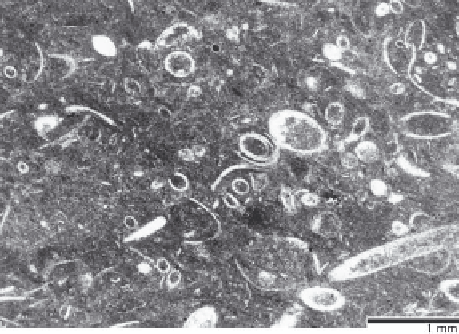Geology Reference
In-Depth Information
carbonates of the peri-Mediterranean region are the
Ammonitico rosso
facies (Farinacci and Elmi 1981;
Caracuel et al. 2000; Pl. 24/2) including the
Adnet lime-
stones
in the Northern Calcareous Alps shown in Pl.
139. Many of these limestones were formed on the top
of drowned Triassic carbonate platforms and represent
examples of 'pelagic carbonate platforms' (Bernoulli
1972; Bernoulli and Jenkyns 1974). Depositional con-
ditions were controlled by water depths (several hun-
dreds of meters), oxygen levels near the sea bottom
(producing gray or red rock colors), bottom current en-
ergy (low to moderate) and autochthonous or alloch-
thonous sedimentation.
Fig. 15.33.
Styliolinid wackestone
deposited on an intrabasinal
swell. The origin of the fine-grained micrite matrix of the
styliolinid limestones and the cephalopod limestones is un-
clear, but is commonly explained as resulting from a breakup
of macroskeletons rather than from calcareous microfossils
or nannofossils that are rare or missing in the Devonian.
Middle Devonian (Givetian): Betic Cordillera, South Spain.
Microfacies of Jurassic limestones of the Ammonitico
rosso and Adnet facies
Microfacies criteria:
Common microfacies criteria
of Jurassic deep-marine limestones are
•
red, gray and white rock colors,
•
lime mudstones, wackestones and packstones,
Devonian cephalopod limestones of western Europe
•
stratigraphic condensation,
•
abundant hardgrounds and discontinuity surfaces,
Near the margin of the Old Red Continent pelagic
limestones were formed adjacent to basins with silty
shales on submarine highs (drowned reefs and volca-
nic seamounts), called 'cephalopod limestone' in Ger-
many and 'Griotte' in France and Spain. The strongly
condensed limestones consist of micrite. The biota are
dominated by pelagic fauna of cephalopods (goniati-
tes, Pl. 90/2; clymenids and orthocone nautilids), thin-
shelled bivalves, styliolinids (Pl. 91/6) and tentaculitids
(Pl. 91/3; Sect. 10.2.4.5), ostracods, radiolarians, and
conodonts. Styliolinid wackestones exhibit a distinc-
tive and typical microfacies (see Fig. 15.33).
The surfaces of hardgrounds are encrusted by sessile
foraminifera and show evidence of submarine corro-
sion. Fe-Mn crusts and lithoclasts are common. Nodu-
lar fabrics are explained as the result of early lithifica-
tion in the muddy calcitic sediments, and later pres-
sure solution accentuating the nodular structure.
The condensed cephalopod limestones were formed
in different water depths on drowned reefs and plat-
forms, volcanic seamounts, and basement highs (Bandel
1974; Tucker 1973, 1974; Wendt and Aigner 1985).
•
Fe-Mn coatings and crusts; manganese nodules (see
Sect. 4.2.4.1),
•
microbial ('stromatolitic') structures (Fig. 10.5),
•
cherts,
•
intercalations of allochthonous limestones (debris
flows, turbidites),
•
neptunian dikes cutting Jurassic and underlying sedi-
ments,
•
'pelagic ooids'.
Common microfacies types
of Jurassic basinal lime-
stones
are (Wilson 1969; Kiessling 1996):
•
Dark pure lime mudstone, finely laminated on a
millimeter scale.
•
Lithoclastic grainstone. Small rock fragments, al-
lochthonous sediments.
•
Radiolarian wackestone and sponge-spicule wacke-
stone.
•
Radiolarian packstone and radiolarian-spicule pack-
stone.
•
Filament wackestone and packstone (Pl. 87/3).
•
Filament-
Saccocoma
-radiolarian wackestone and
packstone.
•
Saccocoma
wackestone and packstone (Fig. 10.56).
15.8.2.2 Microfacies of Mesozoic Basinal
Carbonates
•
Very fine peloidal packstone or grainstone. Micro-
peloids derived from abraded skeletal or lithoclastic
fragments upon the shelf and washed down into
aprons at the foot of the slope.
Widely distributed Triassic deep-marine limestones are
represented by the Late
Triassic
Hallstatt limestone
(Pl.
23/3, 4; Pl. 43/2; Pl. 90/1). Common
Jurassic
pelagic
•
Micro-biolithoclast packstone and grainstone (tur-
bidites).

